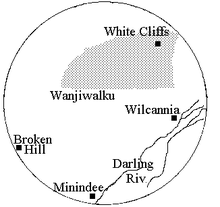Wanjiwalku
The Wanjiwalku were an indigenous Australian people of the state of New South Wales.
Language
Norman Tindale, who had worked intensely with his informant George Dutton, only on Wanjiwalku, argued that, though separate tribes, both the Wanjiwalku and their western neighbours, the Malyangapa, spoke the same dialect.[1] Later studies by Luise Hercus and Peter Austin have determined that Wanjiwalku was a dialect of Paakantyi, while Malyangapa was morphological almost identical to the language spoken by the Yardliyawara, and to be classified as a member of the Yarli dialect cluster.[2]

Country
The Wanjiwalku were estimated by Tindale to have had around 8,000 square miles (21,000 km2) of tribal land extending from the vicinity of Milparinka to White Cliffs, and running east from close to Mount Arrowsmith as far as the area near Tongo Lake. Their lands took in Yancannia and the area east of Lake Bancannia.[1]
Edward Micklethwaite Curr describing the tough environment of Wanjiwalku lands wrote that the earliest white explorer Charles Sturt almost expired there:-
The country of the Pono forms a portion of the interior traversed by Captain Sturt in 1845 and described in such dismal colours as destined to be for ever uninhabitable by civilized people. It was here that, living in an underground room as a protection against the intense heat, his nails ceased to grow; the hairs of his head split at the end; Lucifer matches dropped, from the hand, light of themselves on reaching the ground, and so on; and yet this country has been found for several years to make good sheep-runs.[3]
Alternative names
- Weyneubulkoo
- Wonipalku
- Wanyabalku
- Wonjimalku
- Pono
- Pernowie, Pernowrie
- Kongait
- Tongaranka[1]
Some words
- chukeroo(kangaroo)
- koonai. (tame dog)
- thirita. (wild dog)
- kooma. (father)
- ngumma. (mother)
- birre-birre.' (whiteman)[4]
Notes
Citations
- 1 2 3 Tindale 1974, p. 200.
- ↑ Austin & Hercus 2004, pp. 213,217.
- ↑ Crozier 1886, p. 153.
- ↑ Crozier 1886, p. 154.
Sources
- Austin, Peter; Hercus, Luise (2004). "The Yarli Languages". In Bowern, Claire; Koch, Harold. Australian Languages: Classification and the comparative method. John Benjamins Publishing Company. pp. 207–222. ISBN 978-9-027-29511-8.
- Bonney, Frederic (1884). "On Some Customs of the Aborigines of the River Darling, New South Wales". Journal of the Anthropological Institute of Great Britain and Ireland. 13: 122–137. JSTOR 2841717.
- Crozier, H (1886). "Evelyn Creek" (PDF). In Curr, Edward Micklethwaite. The Australian race: its origin, languages, customs, place of landing in Australia and the routes by which it spread itself over the continent. Volume 2. Melbourne: J. Ferres. pp. 152–155.
- Howitt, Alfred William (1904). The native tribes of south-east Australia (PDF). Macmillan.
- Mathews, R. H. (January 1898a). "Initiation Ceremonies of Australian Tribes". Proceedings of the American Philosophical Society. 37 (157): 54–73. JSTOR 983694.
- Mathews, R. H. (1898b). "Group divisions and initiation ceremonies of the Barkungee tribes". Journal of the Proceedings of the Royal Society of New South Wales. 32: 241–255.
- Morton, A. W. (1886). "Near the North-west corner of New South Wales" (PDF). In Curr, Edward Micklethwaite. The Australian race: its origin, languages, customs, place of landing in Australia and the routes by which it spread itself over the continent. Volume 2. Melbourne: J. Ferres. pp. 158–161.
- Newland, Simpson (1887–1888). "Parkengees, or aboriginal tribes on the Darling River" (PDF). Proceedings of the Royal Geographical Society of Australasia, South Australian Branch. 2: 20–32.
- Newland, Simpson (1926). Memoirs of Simpson Newland. Adelaide: F.W. Preech and Sons.
- Tindale, Norman Barnett (1974). "Wanjiwalku (NSW)". Aboriginal Tribes of Australia: Their Terrain, Environmental Controls, Distribution, Limits, and Proper Names. Australian National University Press. ISBN 978-0-708-10741-6.